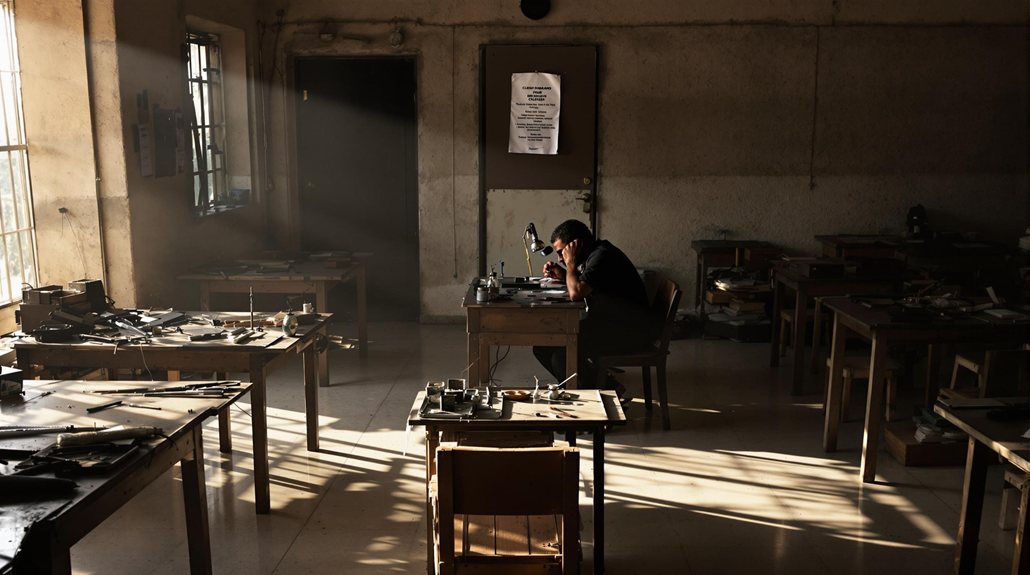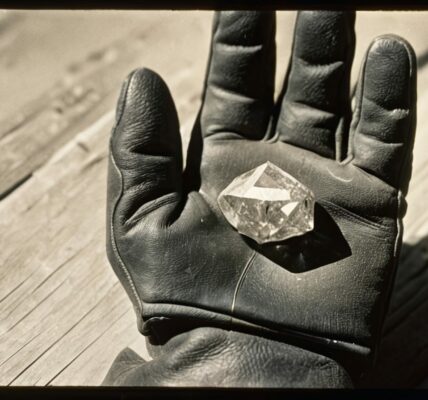Surat’s Diamond Industry Faces Crisis: Layoffs and Closures Mount – Hopes Pinned On Holiday Season Surge
Surat’s diamond industry is facing a severe crisis with significant redundancies and factory closures. Geopolitical issues, such as the Russia-Ukraine conflict and Western sanctions, have disrupted the supply of rough diamonds, causing a steep decline in exports. This downturn has led to over a million job losses and a stark reduction in wages, impacting the local economy heavily reliant on the diamond trade. With 40% of factories shutting down and rising distress among workers, hopes are pinned on a holiday season surge to stabilise the industry. Uncover the challenges and potential solutions shaping Surat’s path forward in this critical period.
Article Contents
- 1 Main Highlights
- 2 Causes of the Crisis
- 3 Impact on Workers
- 4 Industry Statistics
- 5 Government Response
- 6 Economic Impact
- 7 Future Prospects
- 8 Frequently Asked Questions
- 8.1 How Are Local Businesses Outside the Diamond Industry Affected by the Crisis?
- 8.2 What Are the Personal Stories of Workers Affected by Redundancies in Surat?
- 8.3 Are There Any Initiatives to Transition Workers to Alternative Industries?
- 8.4 How Are Remaining Diamond Units Coping With the Reduced Workforce?
- 8.5 What Are the Psychological Support Options Available for Affected Workers?
- 9 Our Final Thoughts
Main Highlights
- Geopolitical tensions and sanctions have severely disrupted Surat’s diamond supply chain, leading to significant challenges within the industry.
- Over 1 million job losses in Surat’s diamond sector have caused widespread financial distress among workers and their families.
- Factory closures and declining diamond exports highlight the economic impact, with 40% of factories having closed and exports projected to decline sharply.
- The diamond industry hopes for a holiday season surge to aid recovery amid decreased demand and competition from lab-grown diamonds.
- Community resilience faces a test as local businesses reliant on diamond workers’ spending grapple with the economic downturn.
Causes of the Crisis
The crisis in Surat’s diamond industry arises from a combination of geopolitical and economic factors that have significantly disrupted its operations. At the core of the turmoil is market volatility, heavily influenced by ongoing global conflicts. The Russia-Ukraine conflict has strained the supply chain of rough diamonds, with the G7 countries imposing a ban on Russian diamonds. This has restricted imports to India, a key player in the diamond industry. Additionally, Western sanctions have further limited the flow of diamonds into India, severely affecting its export capabilities to major markets such as the US, EU, and Hong Kong.
Economically, the industry is experiencing a sharp decline in global demand for polished diamonds, leading to a projected decrease in exports from $23 billion in 2022 to $12 billion by 2024. This decline has caused diamond prices to fall by 5-27%, resulting in an oversupply and complicating financial stability. The emergence of lab-grown diamonds has intensified competition, further unsettling the market. These factors, compounded by reduced working hours in factories, have exacerbated the crisis, highlighting the need for strategic interventions to stabilise the market and restore confidence in Surat’s diamond trade.
Many diamond workers have lost jobs, resulting in significant economic stress on families and communities dependent on this industry. Over 50,000 workers have lost their jobs in the past 8-9 months, underscoring the urgent need for support measures to alleviate their hardships.
Impact on Workers
Amidst the turmoil gripping Surat’s diamond industry, workers bear the brunt of the crisis, facing grave consequences on their livelihoods. The staggering number of 62 suicides among diamond polishers in the past 16 months highlights the severe strain on worker mental health.
Financial distress is rampant, with wages plunging by up to 50% and job losses affecting over 1 million individuals reliant on this sector. Helplines, like the one operated by DWUG, receive over 50 distress calls daily, underscoring the pressing need for mental health support. With ongoing global conflicts like the Russia-Ukraine war exacerbating the situation, the decline in demand for polished diamonds further tightens the economic squeeze on the industry.
The gems and jewellery sector contributes significantly to India’s merchandise exports, making the industry’s struggles a national economic concern.
Financial education becomes essential as workers like Jaysukh Koradiya grapple with mounting debts due to job losses. Stories of hardship, such as Sanjay Patel losing his home to the bank, and Rajesh Savaliya’s struggle to afford school fees, illustrate the dire economic conditions. In response, supportive measures have emerged; donations from figures like Laljibhai Patel help alleviate educational expenses, and the Gujarat Diamond Workers Union advocates for economic relief.
With 40% of factories shuttered, workers’ freedom to secure stable employment remains threatened. The industry hopes for a recovery during the holiday season, offering a potential lifeline to those impacted.
Industry Statistics
Surat’s diamond industry, a cornerstone of India’s economic framework, grapples with significant challenges, affecting both workers and the broader market landscape. The industry, renowned for polishing eight out of every ten diamonds globally, faces steep market challenges that threaten its stability. Despite an 11.32% growth in exports in October 2024, reaching Rs.11,795 crore, the general picture remains concerning.
The industry’s dependency on global markets highlights the volatility it faces amidst geopolitical tensions and economic pressures. The current downturn is part of a larger trend, as India’s diamond industry serves as a crucial base for the national economy. Key statistics illustrate these challenges:
- Export Trends: Surat’s exports, though momentarily improved, are part of a broader decline from $23 billion in 2022 to a projected $12 billion by 2024.
- Production Impact: The supply of rough diamonds has drastically reduced from 5.6 million carats in 2020 to 2.1 million in 2024, affecting production.
- Workforce Strain: The industry employs approximately 600,000 people, but layoffs have reached over 50,000 due to factory closures.
- Market Challenges: Polished diamond prices have dropped by 5-27%, reflecting reduced demand and oversupply issues.
This challenging scenario is contrasted by the recent surge in gem and jewellery exports, which reached USD 2,998.04 million in October 2024, indicating a glimmer of hope for the broader market. These statistics underscore a pressing need for the industry to navigate its market challenges, striving for resilience and sustainability amidst uncertainty.
Government Response
The government’s response to the crisis in Surat’s diamond industry has been criticised for being insufficient, with calls for more robust support for affected workers. Many have urged the government to recognise the severity of the situation and to register the needs of displaced workers, providing necessary aid to stabilise their livelihoods. With the industry already processing 85-90% of the world’s rough diamonds, the current downturn has caused over 30,000 job losses reported in the last six months. The situation is dire, and without timely intervention and concrete measures, the industry’s future and the well-being of its workforce remain in jeopardy.
Insufficient Government Action
Why has the Indian government fallen short in addressing the crisis plaguing Surat’s diamond industry? The answer lies in the lack of government accountability and diplomatic engagement. Despite the industry’s appeals, the government’s response has been inadequate, failing to address the root causes of the crisis. This inaction has led to significant economic and social repercussions.
- Lack of Diplomatic Efforts: The government has not actively engaged in diplomatic discussions with G7 countries to lift sanctions on Russian diamonds, which are vital for the industry. As Congress leader Shaktisinh Gohil has pointed out, immediate intervention is necessary.
- Economic Impact: The decline in diamond exports, from $23 billion in 2022 to a projected $12 billion by 2024, highlights the severe economic challenges. The reduction in Russian diamond availability has exacerbated the situation. Furthermore, the total trade value for diamond companies in Surat has halved during this period, adding to the financial strain.
- Industry Disruption: With 20-25% of units shut and massive job losses, the industry’s future appears bleak. The government has yet to provide the necessary relief package requested by workers’ unions. The lack of a retention strategy to keep skilled workers in the industry further complicates recovery efforts.
- Ineffective Industry Response: While the government promotes lab-grown diamonds, these efforts are insufficient to address the immediate crisis impacting the traditional diamond sector.
Calls for Labour Support
Amid the escalating crisis in Surat’s diamond industry, urgent calls for worker support have intensified, emphasising the dire need for government intervention. The Diamond Workers’ Union of Gujarat (DWUG) has proactively sought financial assistance for workers and their families, urging the Gujarat labour minister to alleviate the economic burden through measures like relaxed loan EMIs and medical benefits. As the industry faces an unprecedented downturn, with stock prices down by 50%, the impact on workers has been devastating, amplifying the necessity for immediate action.
Recognising the critical need for worker welfare, DWUG has also appealed for an extensive relief package to revive the industry and curb the concerning rise in suicides among distressed workers. The introduction of ergonomically designed detachable stool seats with backrests could help improve working conditions, providing some relief to workers facing physical strain.
In response, several government measures have been implemented to address these challenges. A helpline launched by DWUG in July has facilitated over 2,500 distress calls, highlighting the urgency of the situation. Moreover, the Gujarat home minister’s engagement has prompted police involvement to further investigate the union’s concerns.
DWUG, in collaboration with the Gem and Jewellery Export Promotion Council, has provided ration kits to 250 families and covered school fees for 150 families, ensuring some immediate relief.
As the industry grapples with global economic instability, the calls for sustained government support continue, underscoring the critical need for broad financial assistance and long-term worker welfare solutions.
Recognition and Registration Needed
Several critical issues surround the recognition and registration of the diamond industry’s challenges by the government, highlighting a pressing need for decisive action. The Gujarat Congress has urged the Centre to act swiftly, yet Indian foreign minister S Jaishankar has not engaged with stakeholders or addressed the diamond sector’s plight internationally. The lack of diplomatic initiatives and regulatory frameworks has led to widespread criticism of both central and state governments, emphasising the importance of a strategic response to the crisis.
With exports having plummeted from USD 23 billion in 2022 to USD 16 billion in 2023, the need for government intervention has never been more urgent. Congress leader Shaktisinh Gohil has called for the government to champion the industry’s cause on global platforms, particularly concerning sanctions from the G7 countries. The industry, which employs nearly 1 million people, is experiencing significant challenges due to declining global demand and competition from lab-grown diamonds.
Several measures have been proposed to stabilise the sector:
- Safe Harbour Rates: Finance Minister Nirmala Sitharaman’s proposal aims to reduce dependency on intermediary nations by securing raw diamonds directly.
- Lab-Grown Diamonds Initiative: The government supports research grants and reduced customs duties to encourage sustainable alternatives.
- International Diplomatic Engagement: Calls for addressing international sanctions impacting the industry.
- Regulatory Frameworks: Developing strategies to navigate geopolitical tensions affecting supply and demand dynamics.
These efforts, while promising, must be tailored to directly benefit Surat’s diamond industry, ensuring timely and effective implementation.
Economic Impact

The economic impact of Surat’s diamond industry crisis is profound, as persistent employment challenges continue to strain the local economy. As Surat has been recognised as the global hub for the diamond industry, the disruption in this sector significantly affects its economic fabric. With the closure of numerous factories and widespread job losses, thousands of workers face financial uncertainty, which in turn affects local businesses and services reliant on their spending.
The Surat Diamond Bourse, inaugurated by Prime Minister Narendra Modi, was established to centralise diamond trading activities and enhance the global competitiveness of the Indian diamond industry. The pressing need for economic relief and support measures is highlighted by the ongoing advocacy of industry associations, aiming to stabilise both individual livelihoods and the broader economic landscape.
Employment Challenges Continue
Faced with a significant economic downturn, Surat’s diamond industry is grappling with persistent employment challenges that have left thousands of workers in dire straits. The welfare of workers has come under intense scrutiny as job losses and salary cuts continue to mount, pushing many to the brink.
With mental health concerns on the rise, the Diamond Workers Union Gujarat has reported a disturbing increase in distress calls. The situation is dire, marked by a series of troubling statistics:
- Suicides: 71 diamond workers have died by suicide in the past 18 months, highlighting the severe mental health crisis.
- Job Losses: Over 25,000 diamond polishers have lost their jobs, exacerbating the unemployment crisis.
- Factory Closures: Widespread closures have further destabilised the industry.
- Salary Cuts: Daily wage earners have faced a significant reduction in salaries, adding to their economic woes.
The industry, contributing heavily to India’s exports, finds itself at a crossroads. A majority of workers lack permanent or registered employment status, further compounding their vulnerability during this crisis. While the holiday season offers a glimmer of hope for increased demand, the current employment landscape remains bleak. Adding to the complexity, US sanctions on Russian diamonds have left the industry grappling with significant inventory surpluses, highlighting the global challenges impacting local livelihoods.
The need for groundbreaking solutions and a supportive framework for worker welfare is more pressing than ever.
Local Economic Pressure
Amidst the ongoing employment challenges plaguing Surat’s diamond industry, the local economy faces significant strain due to the sector’s downturn. The economic contraction is evident, as industry revenue has sharply declined from Rs 2,25,000 crore in 2022 to Rs 1,15,000 crore over two years.
This downturn is exacerbated by a nearly 28% fall in diamond exports during the 2023-24 financial year, impacting markets like the United States, China, and the United Arab Emirates. Factory closures and reduced production are further signs of distress, with thousands of workers placed on leave. As sanctions on Russian diamonds disrupt supply chains, the reliance on these sources highlights vulnerabilities in Surat’s diamond processing operations. The implementation of extreme measures by companies like Kiran Gems aims to stabilise the industry by controlling production and managing supply effectively.
Surat’s economy, heavily reliant on the diamond industry, now confronts challenges that test local resilience and community adaptation. With 90% of the world’s diamonds processed in the city, this industry has been a cornerstone of economic growth, job creation, and entrepreneurship.
However, its dependency on global markets has made Surat vulnerable to international fluctuations. The strain extends beyond the diamond sector, affecting logistics, hospitality, and other supporting industries.
While there is hope for recovery via holiday season surges and market diversification, the current scenario underscores the need for economic diversification to guarantee long-term stability and resilience.
Future Prospects
Surat’s diamond industry stands at a significant juncture, poised between the challenges of the present and the opportunities of the future. The industry is actively exploring diamond innovation and market strategies to navigate the turbulent waters of global economic shifts.
With the Surat Diamond Bourse set to attract global players, the industry is focused on increasing exports and cementing India’s leadership in the diamond market. Key initiatives are underway to diversify into lab-grown diamonds, offering a sustainable path forward as global demand for luxury goods fluctuates. The opening of trading offices by 250 merchants at the Surat Diamond Bourse signals a promising shift in market dynamics, enhancing business growth and streamlining diamond trading processes.
Looking ahead, the industry’s prospects hinge on several critical factors:
- Surat Diamond Bourse: This new hub is expected to create jobs and improve exports, reinforcing India’s competitive edge.
- Lab-Grown Diamonds: The shift towards this sector offers a strategic advantage, reducing reliance on imported diamonds.
- Technological Advancements: Embracing cutting-edge technology can improve productivity and diamond quality, essential for market resilience.
- Government Support: Crucial for sustaining the workforce, initiatives like loan relaxations and medical benefits are vital for socio-economic stability.
As Surat navigates these prospects, adaptability and innovation will be key to revealing its potential and ensuring a thriving future.
Frequently Asked Questions
How Are Local Businesses Outside the Diamond Industry Affected by the Crisis?
The crisis has led to decreased consumer spending, impacting the local economy and causing small businesses to struggle with reduced demand. This economic downturn hinders growth opportunities, compelling businesses to adapt or face potential closures.
What Are the Personal Stories of Workers Affected by Redundancies in Surat?
Worker testimonials reveal emotional resilience amidst adversity. Many displaced individuals share stories of financial hardship and evolving survival strategies, highlighting their unwavering determination to overcome economic challenges and pursue alternative livelihoods, fostering hope and empowerment within their communities.
Are There Any Initiatives to Transition Workers to Alternative Industries?
Approximately 40% of affected individuals have benefitted from worker retraining programmes, enhancing access to alternative employment opportunities. These initiatives foster economic independence, offering pathways into sectors like textiles and agriculture, while promoting self-sufficiency and adaptability in changing job markets.
How Are Remaining Diamond Units Coping With the Reduced Workforce?
Remaining diamond units are managing with the reduced workforce through strategic workforce adaptation and improving operational efficiency. By reallocating resources and optimising processes, these units aim to maintain productivity levels despite significant workforce reductions, ensuring continued operations and resilience.
What Are the Psychological Support Options Available for Affected Workers?
Imagine a lifeline in turbulent waters; psychological support for affected workers includes counselling services and peer support, offering a guiding light of hope and resilience, enabling them to navigate challenges and reclaim their path to freedom.
Our Final Thoughts
The crisis enveloping Surat’s diamond industry mirrors the challenges faced by industries during times of economic strain, reminiscent of historical downturns. Layoffs and closures, stark reminders of the industry’s vulnerability, highlight the urgent need for strategic revival.
Government intervention and community resilience are crucial as the industry braces for a potential recovery during the holiday season. Observing these developments offers valuable insights into economic adaptability and resilience, providing significant lessons for navigating future challenges in similar sectors.




